Abstract
Psychiatric patients suffering from endogenous depression and a control group without endogenous depression were given oral loads of L-tryptophan and urinary excretion determined of the tryptophan metabolites on the pyrrolase pathway: kynurenine, 3-hydroxykynurenine, and 3-hydroxyanthranilic acid. Female endogenously depressed subjects excreted significantly more kynurenine and 3-hydroxykynurenine but not the subsequent metabolite 3-hydroxyanthranilic acid than did female control subjects. Variability of excretion of kynurenine and 3-hydroxykynurenine at different times by the same subject was much greater in the endogenously depressed than in the control group. There was no consistent temporal relationship between excretion of metabolites and severity of the depressive illness. The possible significance of the findings in relation to defective tryptophan metabolism in the brain in endogenous depression is commented upon.
Full text
PDF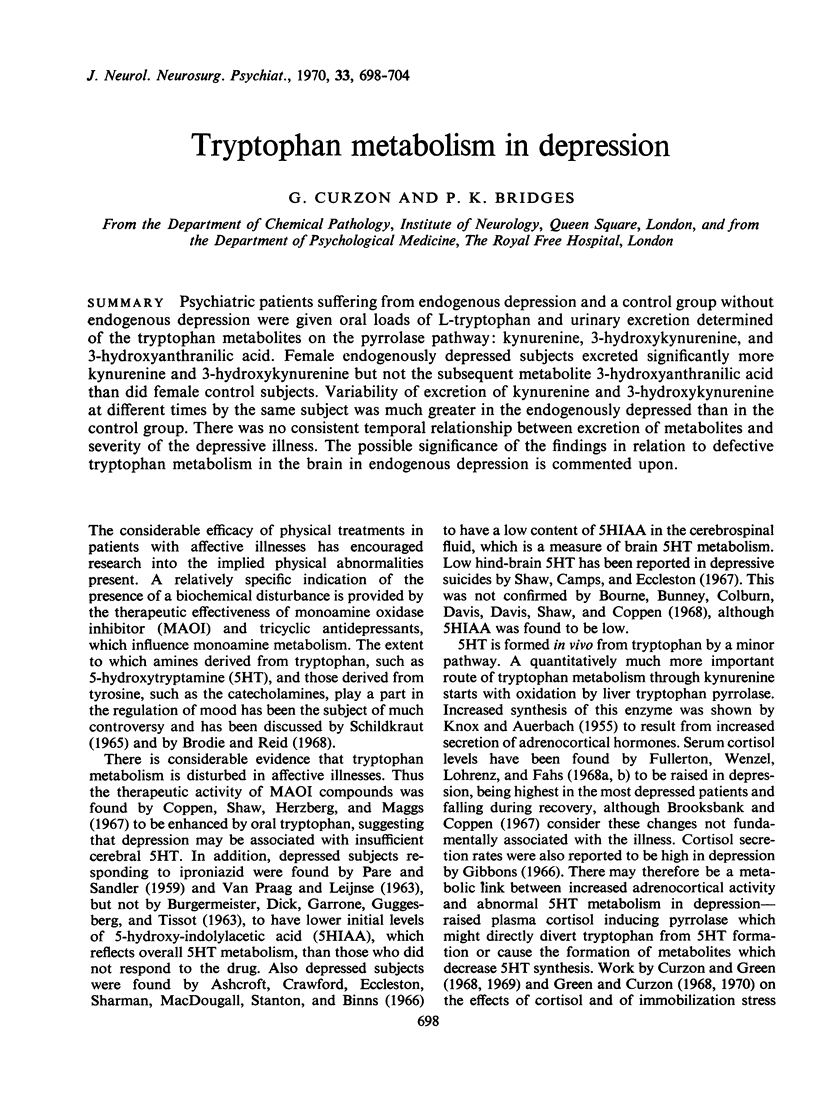
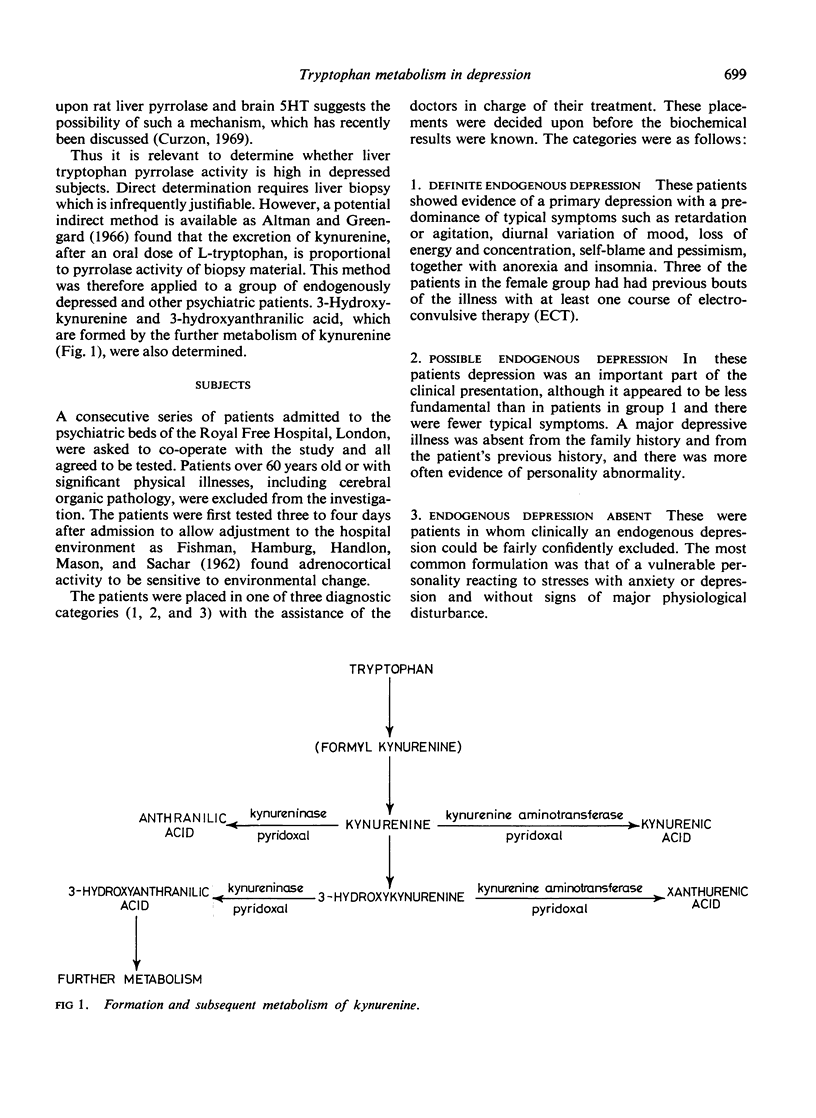
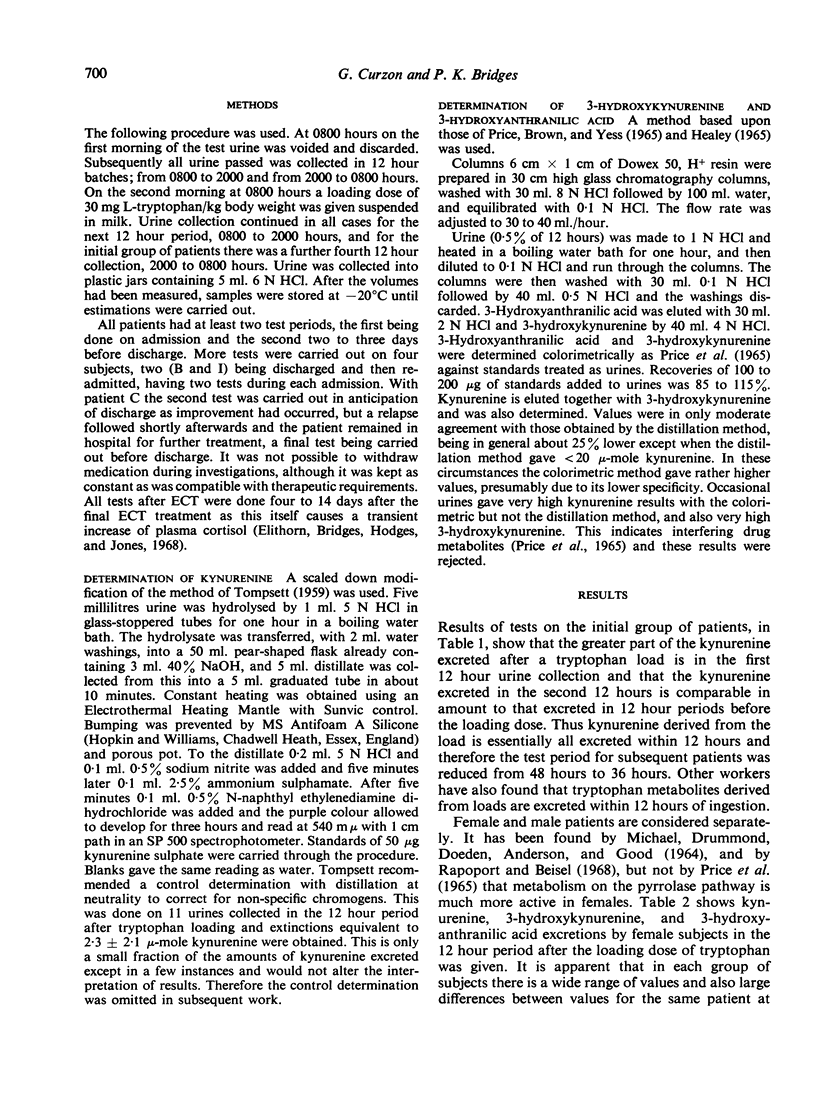
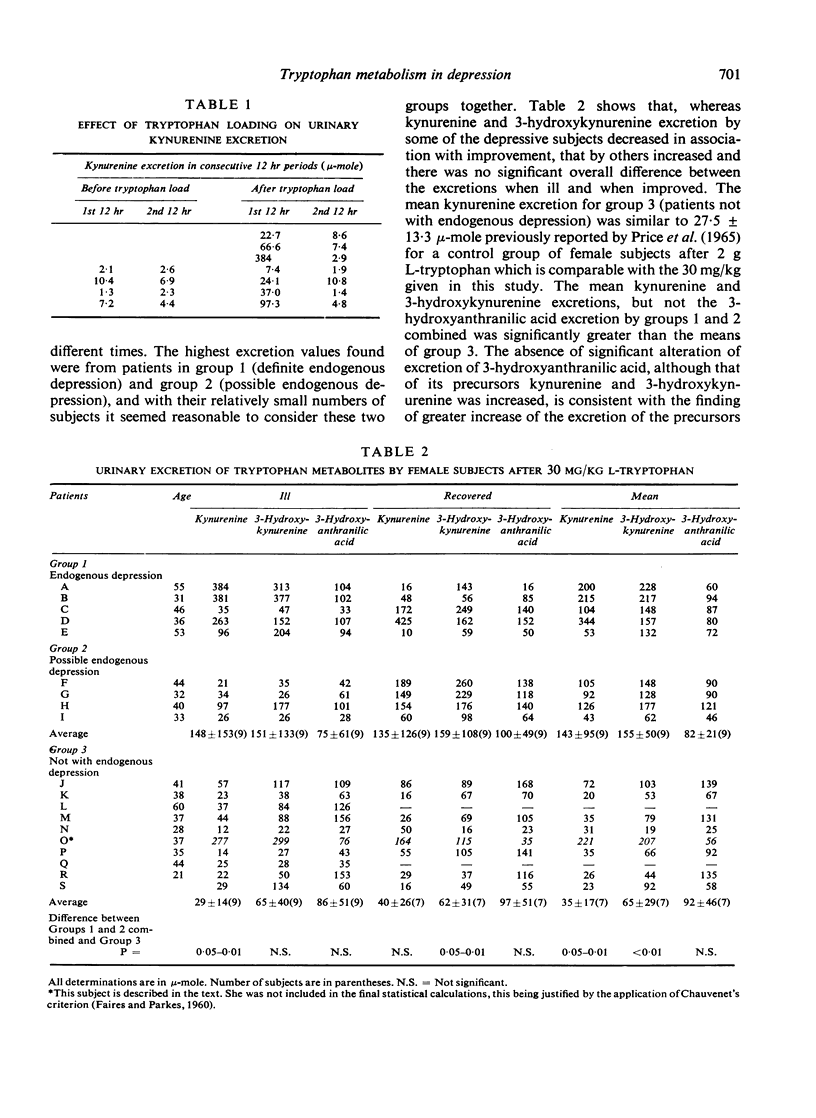
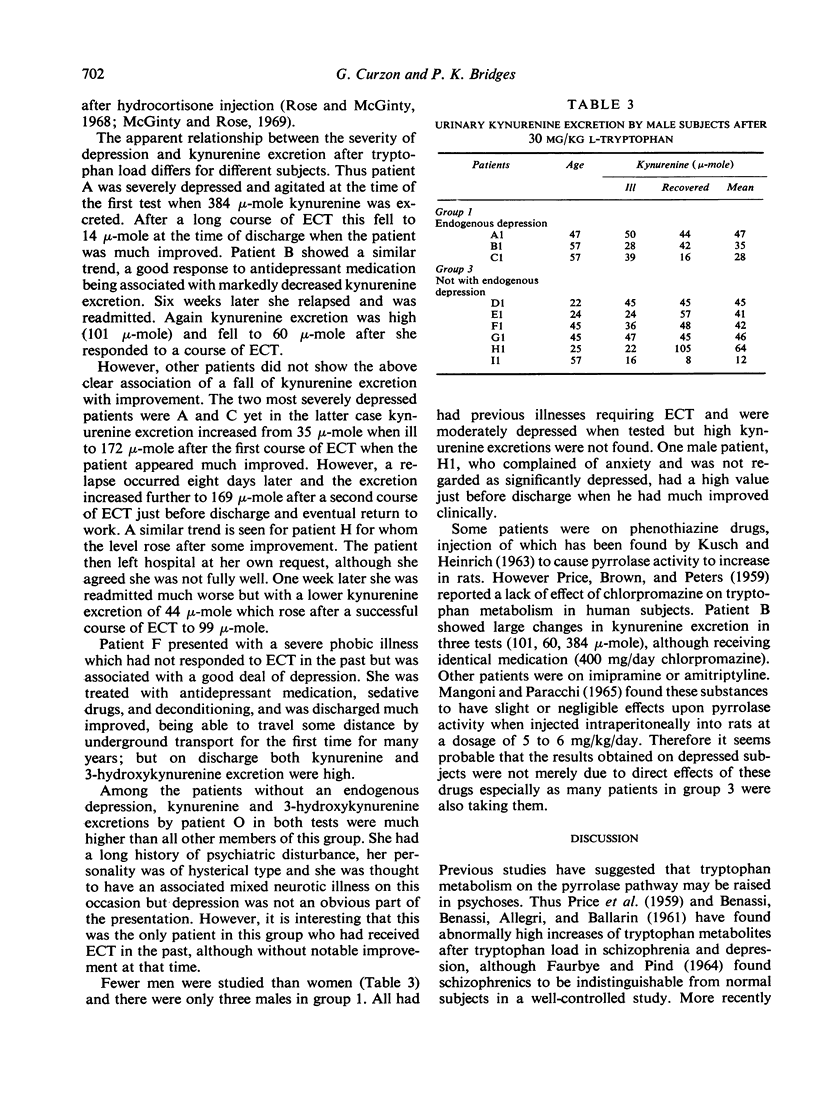
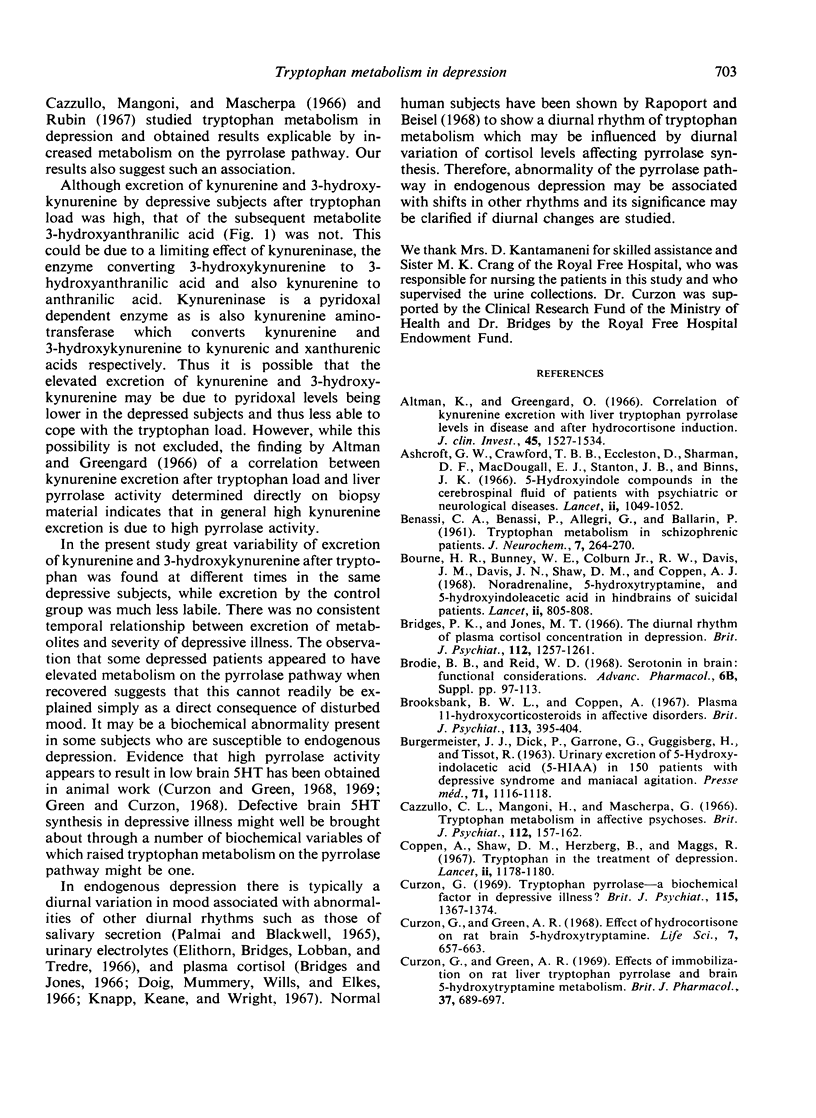
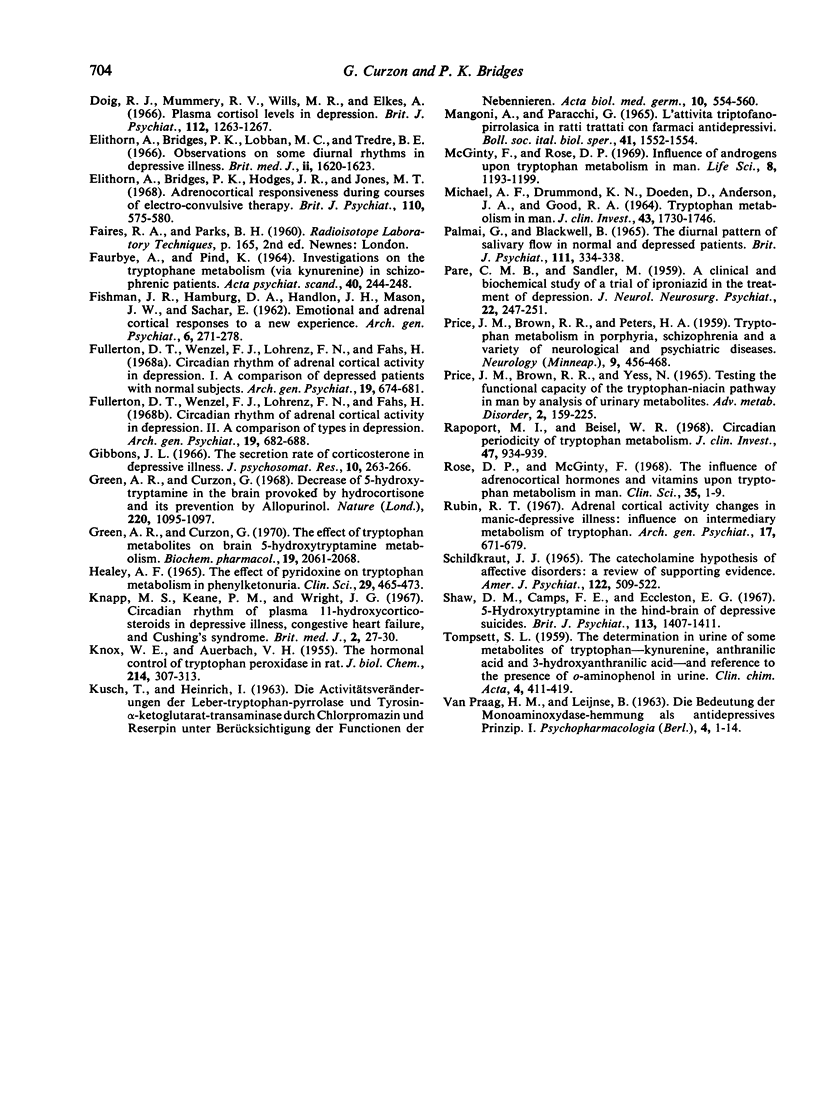
Selected References
These references are in PubMed. This may not be the complete list of references from this article.
- Altman K., Greengard O. Correlation of kynurenine excretion with liver tryptophan pyrrolase levels in disease and after hydrocortisone induction. J Clin Invest. 1966 Oct;45(10):1527–1534. doi: 10.1172/JCI105459. [DOI] [PMC free article] [PubMed] [Google Scholar]
- Ashcroft G. W., Crawford T. B., Eccleston D., Sharman D. F., MacDougall E. J., Stanton J. B., Binns J. K. 5-hydroxyindole compounds in the cerebrospinal fluid of patients with psychiatric or neurological diseases. Lancet. 1966 Nov 12;2(7472):1049–1052. doi: 10.1016/s0140-6736(66)92028-9. [DOI] [PubMed] [Google Scholar]
- BURGERMEISTER J. J., DICK P., GARONNE G., GUGGISBERG M., TISSOT R. [Urinary excretion of 5-hydroxyindolacetic acid (5-HIAA) in 150 patients with depressive syndrome and maniacal agitation. (Its modifications by 5-hydroxy-tryptophan loading and therapy in the depressive states)]. Presse Med. 1963 May 4;71:1116–1118. [PubMed] [Google Scholar]
- Bourne H. R., Bunney W. E., Jr, Colburn R. W., Davis J. M., Davis J. N., Shaw D. M., Coppen A. J. Noradrenaline, 5-hydroxytryptamine, and 5-hydroxyindoleacetic acid in hindbrains of suicidal patients. Lancet. 1968 Oct 12;2(7572):805–808. doi: 10.1016/s0140-6736(68)92459-8. [DOI] [PubMed] [Google Scholar]
- Bridges P. K., Jones M. T. The diurnal rhythm of plasma cortisol concentration in depression. Br J Psychiatry. 1966 Dec;112(493):1257–1261. doi: 10.1192/bjp.112.493.1257. [DOI] [PubMed] [Google Scholar]
- Brodie B. B., Reid W. D. Serotonin in brain: functional considerations. Adv Pharmacol. 1968;6(Pt B Suppl):97–113. doi: 10.1016/s1054-3589(08)60300-2. [DOI] [PubMed] [Google Scholar]
- Brooksbank B. W., Coppen A. Plasma II-hydroxycorticosteroids in affective disorders. Br J Psychiatry. 1967 Apr;113(497):395–404. doi: 10.1192/bjp.113.497.395. [DOI] [PubMed] [Google Scholar]
- Cazzullo C. L., Mangoni A., Mascherpa G. Tryptophan metabolism in affective psychoses. Br J Psychiatry. 1966 Feb;112(483):157–162. doi: 10.1192/bjp.112.483.157. [DOI] [PubMed] [Google Scholar]
- Coppen A., Shaw D. M., Herzberg B., Maggs R. Tryptophan in the treatment of depression. Lancet. 1967 Dec 2;2(7527):1178–1180. doi: 10.1016/s0140-6736(67)91894-6. [DOI] [PubMed] [Google Scholar]
- Curzon G., Green A. R. Effects of immobilization on rat liver tryptophan pyrrolase and brain 5-hydroxytryptamine metabolism. Br J Pharmacol. 1969 Nov;37(3):689–697. doi: 10.1111/j.1476-5381.1969.tb08507.x. [DOI] [PMC free article] [PubMed] [Google Scholar]
- Doig R. J., Mummery R. V., Willis M. R., Elkes A. Plasma cortisol levels in depression. Br J Psychiatry. 1966 Dec;112(493):1263–1267. doi: 10.1192/bjp.112.493.1263. [DOI] [PubMed] [Google Scholar]
- Elithorn A., Bridges P. K., Lobban M. C., Tredre B. E. Observations on some diurnal rhythms in depressive illness. Br Med J. 1966 Dec 31;2(5530):1620–1623. doi: 10.1136/bmj.2.5530.1620. [DOI] [PMC free article] [PubMed] [Google Scholar]
- FAURBYE A., PIND K. INVESTIGATIONS ON THE TRYPTOPHANE METABOLISM (VIA KYNURENINE) IN SCHIZOPHRENIC PATIENTS. Acta Psychiatr Scand. 1964;40:244–248. doi: 10.1111/j.1600-0447.1964.tb05753.x. [DOI] [PubMed] [Google Scholar]
- FISHMAN J. R., HAMBURG D. A., HANDLON J. H., MASON J. W., SACHAR E. Emotional and adrenal cortical responses to a new experience. Effect of social environment. Arch Gen Psychiatry. 1962 Apr;6:271–278. doi: 10.1001/archpsyc.1962.01710220013002. [DOI] [PubMed] [Google Scholar]
- Fullerton D. T., Wenzel F. J., Lohrenz F. N., Fahs H. Circadian rhythm of adrenal cortical activity in depression. I. A comparison of depressed patients with normal subjects. Arch Gen Psychiatry. 1968 Dec;19(6):674–681. doi: 10.1001/archpsyc.1968.01740120034005. [DOI] [PubMed] [Google Scholar]
- Fullerton D. T., Wenzel F. J., Lohrenz F. N., Fahs H. Circadian rhythm of adrenal cortical activity in depression. II. A comparison of types in depression. Arch Gen Psychiatry. 1968 Dec;19(6):682–688. doi: 10.1001/archpsyc.1968.01740120042007. [DOI] [PubMed] [Google Scholar]
- Green A. R., Curzon G. Decrease of 5-hydroxytryptamine in the brain provoked by hydrocortisone and its prevention by allopurinol. Nature. 1968 Dec 14;220(5172):1095–1097. doi: 10.1038/2201095a0. [DOI] [PubMed] [Google Scholar]
- Green A. R., Curzon G. The effect of tryptophan metabolites on brain 5-hydroxytryptamine metabolism. Biochem Pharmacol. 1970 Jun;19(6):2061–2068. doi: 10.1016/0006-2952(70)90303-5. [DOI] [PubMed] [Google Scholar]
- Heeley A. F. The effect of pyridoxine on tryptophan metabolism in phenylketonuria. Clin Sci. 1965 Dec;29(3):465–473. [PubMed] [Google Scholar]
- KNOX W. E., AUERBACH V. H. The hormonal control of tryptophan peroxidase in the rat. J Biol Chem. 1955 May;214(1):307–313. [PubMed] [Google Scholar]
- Knapp M. S., Keane P. M., Wright J. G. Circadian rhythm of plasma 11-hydroxycorticosteroids in depressive illness, congestive heart failure, and Cushing's syndrome. Br Med J. 1967 Apr 1;2(5543):27–30. doi: 10.1136/bmj.2.5543.27. [DOI] [PMC free article] [PubMed] [Google Scholar]
- MICHAEL A. F., DRUMMOND K. N., DOEDEN D., ANDERSON J. A., GOOD R. A. TRYPTOPHAN METABOLISM IN MAN. J Clin Invest. 1964 Sep;43:1730–1746. doi: 10.1172/JCI105048. [DOI] [PMC free article] [PubMed] [Google Scholar]
- Mangoni A., Paracchi G. L'attività triptofano-pirrolasica in ratti trattati con farmaci antidepressivi. Boll Soc Ital Biol Sper. 1965 Dec 31;41(24):1552–1554. [PubMed] [Google Scholar]
- McGinty F., Rose D. P. Influence of androgens upon tryptophan metabolism in man. Life Sci. 1969 Nov 15;8(22):1193–1199. doi: 10.1016/0024-3205(69)90174-x. [DOI] [PubMed] [Google Scholar]
- PALMAI G., BLACKWELL B. THE DIURNAL PATTERN OF SALIVARY FLOW IN NORMAL AND DEPRESSED PATIENTS. Br J Psychiatry. 1965 Apr;111:334–338. doi: 10.1192/bjp.111.473.334. [DOI] [PubMed] [Google Scholar]
- PARE C. M., SANDLER M. A clinical and biochemical study of a trial of iproniazid in the treatment of depression. J Neurol Neurosurg Psychiatry. 1959 Aug;22:247–251. doi: 10.1136/jnnp.22.3.247. [DOI] [PMC free article] [PubMed] [Google Scholar]
- PRICE J. M., BROWN R. R., PETERS H. A. Tryptophan metabolism in porphyria, schizophrenia, and a variety of neurologic and psychiatric diseases. Neurology. 1959 Jul;9(7):456–468. doi: 10.1212/wnl.9.7.456. [DOI] [PubMed] [Google Scholar]
- Price J. M., Brown R. R., Yess N. Testing the functional capacity of the tryptophan-niacin pathway in man by analysis of urinary metabolites. Adv Metab Disord. 1965;2:159–225. doi: 10.1016/b978-1-4831-6750-3.50009-3. [DOI] [PubMed] [Google Scholar]
- Rapoport M. I., Beisel W. R. Circadian periodicity of tryptophan metabolism. J Clin Invest. 1968 Apr;47(4):934–939. doi: 10.1172/JCI105785. [DOI] [PMC free article] [PubMed] [Google Scholar]
- Rose D. P., McGinty F. The influence of adrenocortical hormones and vitamins upon tryptophan metabolism in man. Clin Sci. 1968 Aug;35(1):1–9. [PubMed] [Google Scholar]
- Rubin R. T. Adrenal cortical activity changes in manic-depressive illness. Influence on intermediary metabolism of tryptophan. Arch Gen Psychiatry. 1967 Dec;17(6):671–679. doi: 10.1001/archpsyc.1967.01730300031006. [DOI] [PubMed] [Google Scholar]
- Schildkraut J. J. The catecholamine hypothesis of affective disorders: a review of supporting evidence. Am J Psychiatry. 1965 Nov;122(5):509–522. doi: 10.1176/ajp.122.5.509. [DOI] [PubMed] [Google Scholar]
- Shaw D. M., Camps F. E., Eccleston E. G. 5-Hydroxytryptamine in the hind-brain of depressive suicides. Br J Psychiatry. 1967 Dec;113(505):1407–1411. doi: 10.1192/bjp.113.505.1407. [DOI] [PubMed] [Google Scholar]
- TOMPSETT S. L. The determination in urine of some metabolites of tryptophankynurenine, anthranilic acid and 3-hydroxyanthranilic acid- and reference to the presence of o-aminophenol in urine. Clin Chim Acta. 1959 May;4(3):411–419. doi: 10.1016/0009-8981(59)90112-3. [DOI] [PubMed] [Google Scholar]
- VAN PRAAGH, LEIJNSE B. DIE BEDEUTUNG DER MONOAMINOXYDASEHEMMUNG ALS ANTIDEPRESSIVES PRINZIP. I. Psychopharmacologia. 1963 Feb 22;4:1–14. doi: 10.1007/BF00429359. [DOI] [PubMed] [Google Scholar]


